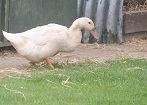Keeping Poultry

Poultry keeping is cheap and simple when you compare it to keeping large animals such as goats, sheep, pigs or cows. Poultry are easy to handle and easy to manage; to keep poultry happy and healthy they need access to sunlight, a dust bath and appropriate (it can be simple) housing, that is well sheltered from cold winds and is vermin/fox proof.
Poultry are widely kept as domesticated animals:
- by subsistence farmers
- for self-sufficiency i.e. eggs and meat
- as pets
- on small scale farms
- on large scale, commercial farms
Laying hens (for example) are popularly kept by the ‘backyard farmer’ or on a small holding for pleasure. Some small holders make a business out of their interest in poultry by breeding them for sale (and sometimes ‘showing’ them) or they sell (or trade) the eggs. Others may set up a full scale farm e.g. free range eggs and chicken, duck or turkey meat or as is the case in many large operations - as caged birds for full scale egg production and meat. Some concentrate on producing certain pure breeds, which they may take to poultry shows and exhibitions, as well as sell them to others interested in pure breeds. Others concentrate on cross breeds suited to meat or egg production. They may sell day old chicks to egg and meat producers while others sell point-of-lay hens.
Some breeders now also offer a ‘trade-in’ service – buyers trade-in their old hens when they buy new layers. That way they do not have the responsibility of not knowing what to do with unproductive hens. The breeder or poultry supplier takes the responsibility for them. This is an excellent service for backyarders that may like to keep a couple of hens for the family as pets and for fresh eggs, but are unable to dispose of them when the time comes.
Chickens
Depending on what your intentions are for raising or keeping chickens, the selection of stock can be important. The breed you choose will offer different benefits. Ornamental breeds are often enjoyed as pets, whereas cross-breeds are mainly used in commercial production as they are capable of laying eggs at a high rate and are exceptionally economical with feed. Cross-breed examples are the White Leghorn male crossed with a female Australorp or the New Hampshire x Rhode Island Red is another good crossbred.
There are various ways you can obtain hens. You can buy them as day old chicks, as pullets or as battery hens. Day old chicks are cheap but require six months of feeding and much care and attention before they start lay.
If you choose not to raise chicks (thus avoiding the possibility of being left with rooster/cock that you may not want), perhaps adopting or buying ex-battery hens could be a good alternative if you want to buy cheaply. Unfortunately, battery hens are in poor condition and could be diseased. They are usually sold off battery farms at about 18 weeks of age. You may not mind this and in fact you make take great enjoyment out of improving their health and quality of life.
For the novice poultry keeper, the easiest way to begin is to buy pullets. If you buy them at 18 weeks of age, they will start laying eggs within a further 4 6 weeks. Planning to introduce a younger group of birds into an established flock should take place. Often very young birds need to be kept from older birds initially – so a separate shed may be required for this.